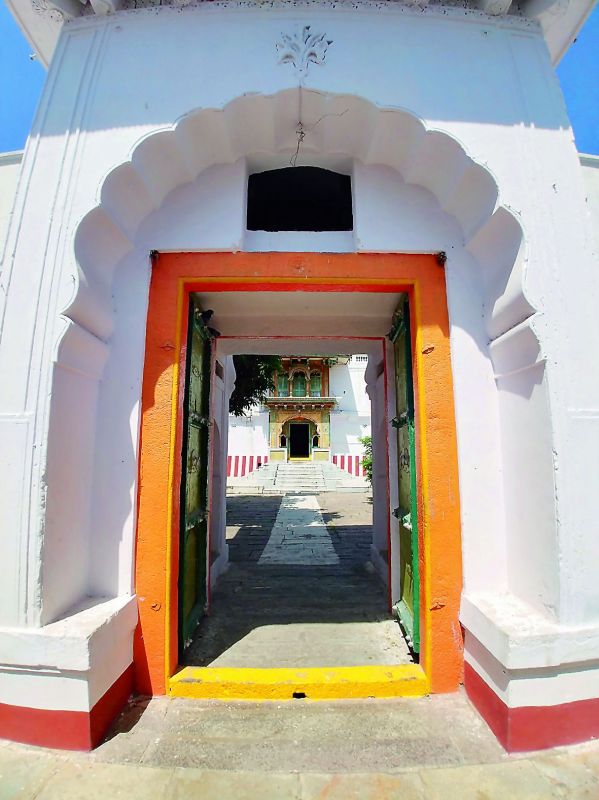Hyderabad: The open secret' temple
Most know of 184-year-old Rama temple redolent with history but few have visited it.

Hyderabad: There are no mangoes on the tree, but the parrots are screeching away. Huge trees stand sentinel to this old structure, birds chirp, pigeons coo from the many nooks. Even though there are devotees, you feel you are all alone in communion with the Lord.
Mr Ramesh Singh, who stays in Mallepally, says, “We knew there was a temple but had never visited it.” After 42 years and on the insistence of his mother he came one morning earlier this week and was astounded.
The Sitarambagh temple is bang in the middle of the most crowded localities of Hyderabad, which is home to Hindus and Muslims in equal numbers. Google gives you the directions, but once you reach Darussalam and lose yourself, all you need to do is ask and a thousand fingers point you to the temple.
 A view of the main temple seen through a door that has Mughal architecture influence.
A view of the main temple seen through a door that has Mughal architecture influence.
“This place was surrounded by forests,” says Arvind Ganeriwal, the fourth generation of Ganeriwals looking after the temple that was built in 1835. It is now surrounded by small shops, residences, godowns and a huge amount of traffic. But the temple is an oasis where you cannot hear a sound, other than the birds and the stage whisper of devotees speaking.
The temple earns its resources from those who build along the boundary wall. “We get enough,” says Arvindji. Though the temple is under the endowments department, there is no fund coming from there. Arvindji says, “they take away from the collection which comes to the priests. When you perform aarti to the gods, people give nazrana. We have no right to take that away. It is for the priests and their welfare.”
There are no hundis and the money given by the devotees is distributed among the 40 Brahmins in attendance.
The architecture of the temple is confusing, even as the two imposing doors awe you. There is the Kakatiya touch which gives the temple solidity, but it is the Rajasthani touch which lends it a unique quality. The colour has faded but you can still feel the richness of the art. It is on the walls, doors and the sanctum sanctorum and is still vibrant.
“Didn’t you see the European influence on the first gate,” asks Arvindji. There is definitely the Moghul touch in the form of a naubat khana where drums, shehnais and other instruments were played. “Nowadays we do not find too many of these musicians. When we do, they are expensive. I just play tapes of nadaswarams,” says Arvindji.
There is a small sunken square with a Moghul look, with chandeliers and balconies running round the square. There is also a small defunct fountain in front of the main sanctum.
There are huge gates in the east, west and the south. What used to be a huge goshala has been converted into rooms where the priests and their families live. As is bound to happen, none of them wants to move away.
The temple hosts the main deity in the Pattabhishekam arrangement, with Sita, Rama, Lakshmana, Bharat, Sahadeva and Hanuman. The main deities and the utsava idols that are paraded during festivals are kept together and worshipped every day.
There is a separate building in the Kakatiya style, hosting Varadarajaswamy and Lakshmi. There are many mandapams, with strong stone pillars and a big permanent rangoli at the centre. There is a huge hall, which is used during the festivals that are celebrated with great pomp, including Ramanavami, Dasara, Mukhoti Ekadasi, Godha Utsav and Janmashtami.
The endowment department has appointed a committee and has drawn up a master plan for the temple. “We have promised the government that we will not take any money from them for the renovation, but we are yet to get permissions,” says Arvindji, choosing his words carefully.
Ram Charit Mishra who conducts pujas is from Rewa, MP, and has been here for three years. “We are mere instruments in His hand, and will go wherever He chooses,” he says.
“This temple is governed by three states,” said Arvindji, talking about the land given by the then Berar kingdom in Maharashtra and a similar temple being run by Arvindji's brother at Pushkar in Rajasthan and the one in Hyderabad.
He talks about the difference of approach between the Rajasthan and the TS governments. “My brother has done restoration work in Rajasthan with all the permissions coming to him easily, but here I keep waiting.”
The temple received the Indian National Trust for Art and Cultural Heritage (Intach) heritage building award in 2000, Arvindji insists that they would like to keep low because “my intention is to serve the Lord.” The temple won the Hyderabad Urban Development Authority-Intach award for 2001.
“I was a naastik when I was in medical college in Nagpur,” Arvindji reminisces. He completed his MS in general surgery and MS in orthopaedics and was a consultant with the Sagarlal Memorial Hospital and a few others. Now, at 75, his focus is on running the temple, where he is assisted by his wife Asha. Only his elder son Srivatsa, sole distributor of Patanjali products, shows interest in the temple. The second son, Rohit, is a doctor at Amaravati, Maharashtra, his daughter stays in Bengaluru.

